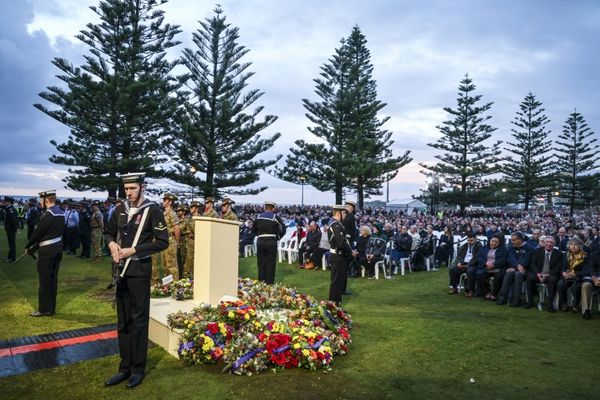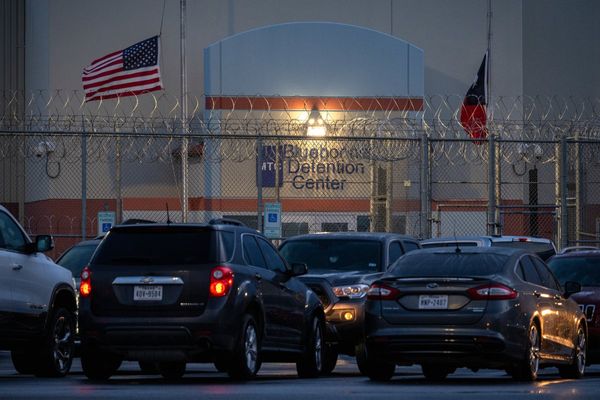Frame by frame, the wildlife living on a Queensland cattle station are revealed. A long-eared bilby is caught mid-hop on a gibber plain, the name given to the densely packed rocks of the desert pavement. The eyes of an endangered kowari – a palm-sized carnivorous marsupial with a bottle-brush tail – glow an eerie white. A feral cat stalks past and a curious dingo eyeballs the trail camera, one of eight planted on a North Australian Pastoral Company (Napco) property in the channel country as part of a joint biodiversity project with Australian Wildlife Conservancy.
Napco, which manages a 6m hectare cattle estate across northern Australia, first invited AWC ecologists to undertake an ecological assessment on its western Queensland properties in 2020. The ecologists recorded 51 bird species, 10 reptile, seven mammal and six types of frog.
That spawned a two-year pilot project involving the deployment of eight remote monitoring stations with motion-detection cameras and solar-powered bio-acoustic recorders (BAR), which collect data 24 hours a day. The project hoped to find three target species: the greater bilby, kowari and plains-wanderer.
Greater bilby numbers are estimated to be fewer than 10,000, giving it a conservation status of vulnerable. The kowari also has an estimated population of fewer than 10,000, with a conservation status ranging from vulnerable in Queensland and endangered in South Australia to extinct in the Northern Territory. There are estimated to be as few 250 critically endangered plains-wanderers – elusive ground-dwelling birds – across the country.
The camera footage was analysed through AWC’s AI-driven wildlife recognition technology, overseen by Dr Alexander Watson, a regional ecologist.
Kowari were photographed at each site, which Watson says is “a great indication that the population is widespread and doing relatively well”. The greater bilby was photographed at two sites and the plains-wanderer at none, though Watson is confident bio-acoustic recordings, which are yet to be analysed by new technology being developed at the Queensland University of Technology, will reveal the bird’s presence.
“The cameras are set up for mammals, but the bio-acoustics are designed for bird calls,” Watson says. “The plains-wanderers are very cryptic birds, and we would be extremely lucky for one to walk in front of a camera, but they have been sighted on a neighbouring property and I have no reason to believe they are not here.”
While bio-acoustics are being fine-tuned, motion cameras have long played a part in ecological surveys, picking up sightings of everything from the rare night parrot to the occasional naked human. On the Napco property, alongside the kowari and bilby cameras collected images of other vulnerable species, including letter-wing kites and black falcons.
The camera monitoring program is part of nationwide wildlife survey work by the organisation, which included a sighting of Australia’s rarest raptor the red goshawk at the AWC’s Newhaven sanctuary last month – the first time the bird had been seen in central Australia for 30 years.
The pilot project, funded by the Queensland government’s threatened species research grants, was used to help refine the use of AI recognition software for both visual and aural diagnostics. An additional 60 monitoring sites have already been deployed across Napco stations.
The monitoring cameras also track the presence of feral cats, the biggest threat to ground-dwelling native species and nesting birds. Feral cats were detected at half of the Napco camera sites and Watson says ecologists were “alarmed by the number of feral cats seen resting in raptor nests along creek lines”.
Monitoring stations were placed both in nature reserves and in cattle paddocks across the station. Watson says the presence of native species alongside livestock suggests the two may be able to coexist if the land is managed correctly. “We are at the beginning of understanding the dynamics between cattle and conservation and this is important work in exploring how we can best work with pastoralists,” he says.
The cameras also detected multiple dingos across the Mitchell Grass downs and gibber plains, the animals’ natural curiosity making for up close and personal shots. Managing the coexistance of dingoes with livestock is a trickier challenge, with many pastoralists still harbouring a deep animosity to the native dogs, but it is a possibility being explored by AWC and Napco.
Napco’s chief executive, Allan Cooney, says the project is an opportunity to quantify the benefits of responsible pastoral management with meaningful conservation efforts. The company manages about 200,000 head of cattle and has dedicated 385,000ha as a nature reserve.
“Our partnership with AWC allows us to deepen our understanding of the native and endangered species across our expansive estate,” he says. “The data collected through this collaboration is invaluable for guiding sustainable practices that safeguard both wildlife and the resilience of these unique ecosystems.
“We’re proud to see our land contributing to the preservation of Australia’s threatened species and look forward to continuing this important work.”
AWC’s CEO, Tim Allard, said cross-sector collaboration is necessary. “With about 44% of Australia covered by pastoral land, collaboration is key to significantly scaling up conservation across the country and for securing the future of Australia’s threatened wildlife.”







